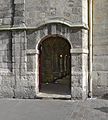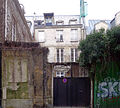
The Rue de Rivoli is a street in central Paris, France. It is a commercial street whose shops include leading fashionable brands. It bears the name of Napoleon's early victory against the Austrian army, at the Battle of Rivoli, fought on 14–15 January 1797. Developed by Napoleon through the heart of the city, it includes on one side the north wing of the Louvre Palace and the Tuileries Gardens.
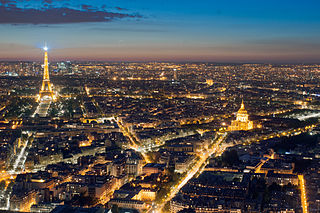
The 7th arrondissement of Paris is one of the 20 arrondissements of the capital city of France. In spoken French, this arrondissement is referred to as le septième.
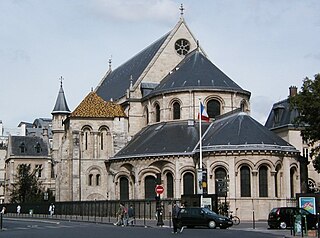
The 3rd arrondissement of Paris is one of the 20 arrondissements (districts) of the capital city of France. In spoken French, this arrondissement is colloquially referred to as "le troisième" meaning "the third". Its postal code is 75003. It is governed locally together with the 1st, 2nd and 4th arrondissements, with which it forms the 1st sector of Paris, Paris Centre.

The 4th arrondissement of Paris is one of the twenty arrondissements of the capital city of France. In spoken French, this arrondissement is referred to as quatrième. Along with the 1st, 2nd and 3rd arrondissements, it is in the first sector of Paris, which maintains a single local government rather than four separate ones.
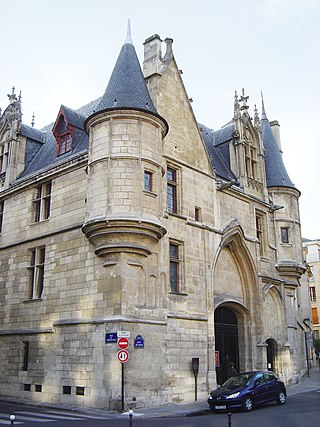
The Marais is a historic district in Paris, France. It spreads across parts of the 3rd and 4th arrondissements on the Rive Droite, or Right Bank, of the Seine. Having once been an aristocratic district, it is home to many buildings of historic and architectural importance. It lost its status as a fashionable district in the late 18th century, with only minor nobles calling the area home. After the French Revolution, the district fell into disrepair and was abandoned by nobility. After a long period of decay, the district has undergone transformation in recent years and is now once again amongst the more fashionable areas of Paris, known for its art galleries, upscale restaurants and museums.
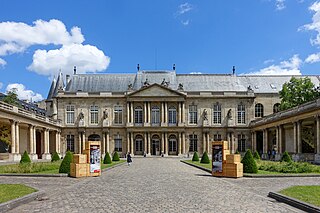
The Hôtel de Soubise is a city mansion entre cour et jardin. It is located at 60 Rue des Francs-Bourgeois in the 3rd arrondissement of Paris, France.
The Rue des Francs-Bourgeois is one of the longer streets in the Marais district of Paris, France.

Germain Boffrand was a French architect. A pupil of Jules Hardouin-Mansart, Germain Boffrand was one of the main creators of the precursor to Rococo called the style Régence, and in his interiors, of the Rococo itself. In his exteriors he held to a monumental Late Baroque classicism with some innovations in spatial planning that were exceptional in France. His major commissions, culminating in his interiors at the Hôtel de Soubise, were memorialised in his treatise Livre d'architecture, published in 1745, which served to disseminate the French Louis XV style throughout Europe.

The Rue Saint-Honoré is a street in the 1st arrondissement of Paris, France. It is named after the collegial Saint-Honoré church, situated in ancient times within the cloisters of Saint-Honoré.

Faubourg Saint-Germain is a historic district of Paris, France. The Faubourg has long been known as the favourite home of the French high nobility and hosts many aristocratic hôtels particuliers. It is currently part of the 7th arrondissement of Paris.

Jean Beausire was an architect, engineer and fountain-maker and the chief of public works in Paris for King Louis XIV of France and King Louis XV of France between 1684 and 1740, and was the architect of all the public fountains constructed in Paris that period. Several of his fountains still exist and continue to work. Three streets in the 4th arrondissement of Paris today carry his name: Rue Jean-Beausire, Impasse Jean-Beausire, and Passage Jean-Beausire.

The Marché des Enfants Rouges is the oldest covered market in Paris, France. It was established in 1628 as the "petit marché du Marais" and is located at 39 Rue de Bretagne in the Marais (3rd) arrondissement. The market has been listed as a historic monument since 1982.
The Rue Rambuteau is a street in central Paris, France, named after the Count de Rambuteau who started the widening of the road prior to Haussmann's renovation of Paris. The philosopher Henri Lefebvre lived on the street and observed from his window the rhythms of everyday life at the intersection located behind the Centre Georges Pompidou.
This article presents the main landmarks in the city of Paris within administrative limits, divided by its 20 arrondissements. Landmarks located in the suburbs of Paris, outside of its administrative limits, while within the metropolitan area are not included in this article.

The Rue Coquillière is one of the oldest paths of the 1st arrondissement of Paris, France.

The Rue de Valois is a street in the Palais-Royal quarter in the 1st arrondissement of Paris, France.

The Place Harvey Milk is a public square in Paris, France. It lies at a junction in Le Marais, at the intersection of the Rue des Archives and the Rue de la Verrerie, at the heart of the French capital.

Hôtel de Guénégaud or Hôtel de Guénégaud-des-Brosses is a 17th-century hôtel particulier, or large townhouse, in Paris.



